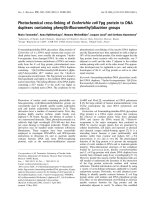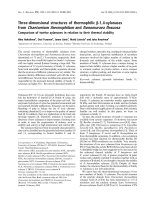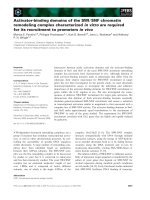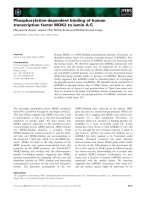báo cáo khoa học: " ’To take care of the patients’: Qualitative analysis of Veterans Health Administration personnel experiences with a clinical informatics system" ppsx
Bạn đang xem bản rút gọn của tài liệu. Xem và tải ngay bản đầy đủ của tài liệu tại đây (256.71 KB, 8 trang )
RESEARC H ARTIC LE Open Access
’To take care of the patients’: Qualitative analysis
of Veterans Health Administration personnel
experiences with a clinical informatics system
Laura M Bonner
1,2*
, Carol E Simons
1
, Louise E Parker
3,4
, Elizabeth M Yano
5,6
, JoAnn E Kirchner
7,8,9
Abstract
Background: The Veterans Health Administration (VA) has invested significant resources in designing and
implementing a comprehensive electronic health record (EHR) that supports clinical priorities. EHRs in general have
been difficult to implement, with unclear cost-effectiveness. We describe VA clinical personnel interactions with
and evaluations of the EHR.
Methods: As part of an evaluation of a quality improvement initiative, we interviewed 72 VA clinicians and
managers using a semi-structured interview format. We conducted a qualitative analysis of interview transcripts,
examining themes relating to participants’ interactions with and evaluations of the VA EHR.
Results: Participants described their perceptions of the positive and negative effects of the EHR on their clinical
workflow. Although they appreciated the speed and ease of documentation that the EHR afforded, they were
concerned about the time cost of using the technology and the technology’s potential for detracting from
interpersonal interactions.
Conclusions: VA personnel value EHRs’ contributions to supporting communication, education, and
documentation. However, participan ts are concerned about EHRs’ potential interference with other important
aspects of healthcare, such as time for clinical care and interpersonal communication with patients and colleagues.
We propose that initial implementation of an EHR is one step in an iterative process of ongoing quality
improvement.
Background
Recent research and national healthcare policy discus-
sions have highlighted the potential of electronic health
records (EHRs) to improve quality and efficiency [1-3]
and potentially to reduce healthcare costs [4,5]. Many
large healthcare organizations have implemented some
form of healthcare informatics, but few have compre-
hensive systems [6]. EHRs have been difficult to imple-
ment [7], and their cost-effectiveness remains unclear
[8-10]. For example, the British National Health Service
has experienced ‘costly delays’ in implemen tation of its
EHR [11]. Researchers have identified many barriers to
implementation, including increased documentation
time [12,13], interference with clinical workflow, appre-
hension about uninte nded negative consequences , finan-
cial concerns, physician resistance, maintenance costs,
and inadequate information technology (IT) staff to sup-
port implementation, among others [6,14,15].
The Plan-Do-Study-Act cy cle (PDSA) provides a use-
ful framework for evaluating system change [16], and
can be used to conceptualize EHR implementation.
Informatics systems such as the EHR are designed and
built to meet clinical needs (in the ‘Plan’ phase). The
EHR is t hen implemented (in the ‘Do’ phase), and end-
users provide feedback (during the ‘Study’ phase) that
drives further refinement of the informatics system (dur-
ing the ‘Act’ phase). In this framework, feedback from
end-users is essential to make the EHR more acceptable
to clinicians and more useful to t he organization. The
ITSA model [17] likewise describes a recursiv e relation-
ship in which interactions between health IT and the
* Correspondence:
1
Health Services Research and Development Northwest Center of Excellence
for Outcomes Research in Older Adults, VA Puget Sound Healthcare System,
Seattle, WA, USA
Full list of author information is available at the end of the article
Bonner et al. Implementation Science 2010, 5:63
/>Implementation
Science
© 2010 Bonner et al; licensee BioMed Central Ltd. This is an Open Access article distributed under the terms of the Creative Commons
Attribution License ( which permits unrestricted use, distribution, and reproduction in
any medium, provided the original work is prop erly cited.
larger clinical environment shape development of both
the EHR and the larger environment. In both models,
awareness of how end-users interact with the EHR is
essential for successful implementation and improve-
ment of the informatics system. Concretely, structured
usability testing can generate valuable data about what
end-users like and dislike about software. Likewise, in
an article describing the implementation of the Veterans
Health Administration’s (VA) EHR, Evans and collea-
gues identify an ‘iterative partnership’ between users and
developers as central to the success of EHR implementa-
tion [18].
The VA has invested significant time and resources in
the development and implementation of a sophisticated,
multifunctional EHR [19]. The VA first implemented its
EHR, the Computerized Patient Record System (CPRS),
widely in the mid-1990’s, and today there is almost uni-
versal CPRS use among VA clinicians [19]. Among
other important functions, CPRS supports communica-
tion among treatment team members and provides deci-
sion support in various forms, including reminders for
important clinical tasks [20].
The purpose of this article is to describe VA staff
members’ experiences with the VA’s EHR, as implemen-
ted in clinical settings. Participan ts describe both bar-
riers to implementation and the value added to the
organization by the EHR. Participants’ recommendations
may help healthcare administrators anticipate barriers to
EHR implementation and work to a ddress them, while
at the same time increasing adoption by enhancing the
features valued by staff.
Methods
We collected the data presented here as part of the Cost
and Value of Evidence-Based Solutions for Depression
Study (COVES) [21,22]. COVES evaluated the VA
TIDES [23,24] (Translating Initiatives for Depression
into Effective Solutions) depression care initiative, a
clinic-level quality improvement (QI) intervention to
enhance depression treatment in primary care. The VA
is a national healthcare system, divided into 21 distinct
geographic regions or VISNs (VA Integrated Service
Networks). The TIDES team implemented the program
in seven primary care clinics across three VISNs.
As part of the COVES study, pairs of investigators
conducted semi-structured i ntervie ws with VA person-
nel at five of the seven participating TIDES sites. We
were unable to conduct interviews at one of the sites
because the site experienced extremely severe hurricane
damage. One other site was one of two clinics affiliated
with the same parent facility; interviews were conducted
at the other of those clinics. The stud y received Institu-
tional Review Board (IRB) review and approval from
participatinginstitutionsaswellasfromthe
administrative sites. We conducted the majority of the
interviews (N = 67) in face-to-face meetings during site
visits; we conducted telephone interviews with five addi-
tional participants who were not available during our
site visits for a total of 72 interviews with VA personnel.
We provide a description of participants’ organizatio nal
roles (Table 1). At each site, we selected participants
who had been exposed to the TIDES intervention and
who represented differ ent disciplines and different posi-
tions within the organization. Our goal was to gain a
wide representation of VA stakeholders rather than a
comp lete set of stakeholders from one site or discipline.
We believe this sampling strategy accurately reflects the
real-world implementation process, in which the success
of a given initiati ve depen ds on support across sites and
disciplines.
A psychiatrist, a psychologist, a social worker, and two
doctoral level health services researchers served as inter-
viewers. We audio-recorded all interviews and analyzed
the resulting verbatim transcripts using qualitative data
management software [25]. The research team devel-
oped 22 top-level codes relating to different aspects of
the TIDES intervention. Four investigators (the first,
second, and third authors and one of the interviewers)
conducted the top-level coding, assigning codes to
blocks of text (i.e., quotations) within transcripts. Quota-
tions are frequently associated with multiple codes.
After the initi al top-level coding process, two investiga-
tors reviewed 20% of the interview transcripts for coding
consistency. The methodology for ensuring coding con-
sistency has been described in detail elsewhere [21].
Coding agreement statistics were not calculated. Rather,
these two investigators worked with other investigators
to reach coding consistency, resolved disagreements
through discussion and consensus, and reviewed codes
that investigators had difficulty coding consistently.
Table 1 Participant Characteristics
Participant Role Number of
participants
Primary Care Physician 18
Primary Care Physician Assistant 5
Primary Care Advanced Practice Nurse (APN) 1
Primary Care Registered Nurse (RN) 10
Psychiatrist 5
Mental Health APN 3
Psychologist 1
Mental Health Social Worker 1
Non-clinical administrator 5
Medical center or regional network manager 19
Care managers (RNs specializing in depression
disease management)
4
Bonner et al. Implementation Science 2010, 5:63
/>Page 2 of 8
Also, word searches were conducted on all transcripts to
detect any missing code-content links . For example, the
word ‘email’ was searched to ensure that all quotations
containing ‘email’ were properly coded with the ‘infor-
matics’ code (as well as any other applicable codes).
This intensive process ensured a high degree of coding
consistency.
We created 22 top-level codes for this study. In this
article, we present data relating to one of these codes,
‘informati cs’. We list the other 21 codes in Table 2.
These codes either reflect other aspects of the implemen-
tation process or are specific to the parent QI initiative.
The study was very large, yielding thousands of pages of
qualitative data. It would not be possible to integrate all
of these data into one meaningful paper. Ar ticles inte-
grating several other codes have been published or are
currently in preparation. One published article [21] inte-
grates subcodes of the following top-level codes: ‘imple-
mentation/spread process’, ‘participation in design and
customization’ and ‘ideal model’ to describe the process
of quality improvement within healthcare organizations.
In a manuscript in press, Kirchner and colleagues analyze
subcodes of t he ‘implementation/spread process’ and
‘ideal model’ codes specifically in relationshi p to different
stakeholders’ perspect ives; they have presented this work
at a conference [22]. Parker and colleagues synthesized
information from the ‘clinical innovativeness’ and
‘individual, site, VAMC, VISN, and VA characteristics’
codes for a conference presentation [26] and are cur-
rently preparing a related manuscript. Yano and collea-
gues are currently preparing a methodological
man uscript integrating si x subco des of the ‘TIDES activ-
ities’ code to describe o ur approach to measuring imple-
mentation fidelity, in this case fidelity to the original
depression collaborative care model elements. The
‘TIDES program ranking rationale’ and ‘DCM ranking
rationale’ codes formed the basis of a conference presen-
tation [27]. Some codes, including ‘human subjects’ activ-
ities’, yielded relatively little information, and we are
therefore unlikely to develop papers based on them.
The themes derived from the 432 informatics quota-
tions did not generally integr ate well with findings from
the other codes, and thus would not have b een appro-
priate for incorporation into other publications
(although some individual quotations were assigned a
code or codes in addition to ‘ informatics’). Respondents
made comments about the VA EHR in general; they did
not confine their remarks to the role of the EHR in this
QI project. Therefore, we have chosen to present ‘infor-
matics’ separ ately from other codes. Codes were not
separated by site, or by profession of respondent. How-
ever, we note the respondent’
s profession with each
quote as this information may provide important con-
text for the reader.
Two in vestigators (the first and second authors) devel-
oped sub-codes that reflected the content of quotations
associated with the informatics top-level code (see Table
3). The same two investigators each worked with one-
halfofthetranscriptsandassignedoneormoresub-
codes to all quotations associated with the informatics
top-level code. These two investigators then reviewed
each other’s sub-coding and met to resolve discrepan-
cies. Finally, these investigators developed summaries of
the themes discussed in relation to each subcode.
Results
Barriers
Study participants described barriers to their use of the
EHR. Recent research documents that the average pri-
mary care visit takes 20.8 minutes, with additional time
required for counseling and screening [28]; other
research has found that about five minutes are allocated
to the longest topic during the visit, with each additional
topic receiving slightly more than one minute [29]. Time
has been identified as a significant barrier to use of clin-
ical reminders [30]. Participants accordingly expressed
concerns about time management:
‘CPRS is great, but it takes time to use [Providers]
have to see very complicated patients in 20 minutes,
and so anythi ng that’s in a ddition to is going to be
Table 2 Top-level codes
TIDES Activities
Implementation/Spread Process
Involvement
Participation in Design and Customization
Barriers to quality depression care
TIDES Positive
TIDES Negative
Change in attitudes and behavior since TIDES
Remain post-study
TIDES program ranking rationale
DCM ranking rationale
Depression as a chronic illness
Facility depression care quality
Ideal model/suggestions for improvement
TIDES model population applicability
Clinic interaction/collaboration
Clinic innovativeness
Individual, site, VAMC, VISN & VA Characteristics
Informatics
Perceived consumer ability to affect change
Consumer depression related interest and activity
Human subjects issues
Bonner et al. Implementation Science 2010, 5:63
/>Page 3 of 8
negatively perceived With every point and click on
a computer it’slesstimetheyspendwithapatient.
They generally just want to take care of the patients.’
(Primary Care Nurse)
‘I’mtheclickcounter.IthinkonetimeIsent[an
administrator] an e-mail about how many clicks it
took to take care of a diabetic patient, because I
clicked through all the reminders and I mean it’s
hundreds.’ (Primary Care Physician)
As converging evidence, barriers to the effective use of
clinical reminders have been do cumented previously.
These barriers include number of reminders and presen-
tation of inapplicable reminders [30].
Another barrier was apprehension that the EHR would
lead to impersonal interactions between staff and
patients, and perhaps even between staff members. Clin-
icians expressed concerns about the impersonal nature
of reminder-driven interactions, which in their experi-
ence made filling out forms rather than listening to
patients the priority:
‘Well, you know, clinical remi nders are fine, but less
and less they bring in i ndep endent thought, a provi-
derthataskstherightquestionsandshowinterest
in the patient.’ (Psychiatrist)
‘I just feel like that the personal I mean, what hap-
pened with talking face to face with someone.’ (Pri-
mary Care Physician Assistant)
‘All these blasted checklists, clerks should be doing
that Doctors need to sit there and look someone
in the eye What’s really bothering you? How can I
help you today?’ (Psychiatrist)
As converging evidence, DeBlasio and Walker [31]
examined the perceived quality of care delivered in a
simulated medical interview. Simulated interviews using
a desktop computer were rated lower than those using
less obtrusive technolog ies or no technology, suggesting
that EHR use may be perceived as interfering in the
clinical relationship.
Complex clinical discussions require interpersonal
trust between professionals, and it is preferable to con-
duct sensitive discussions in person. In the words of one
case manager, ‘I’m asking physicians in [another VA
facility] to know me and trust me simply by what th ey
have read in my progress notes and most of them
have not met me personally.’
A primary care RN observed, ‘[T]here are a lot of
things you don’t want to put it as a formal note in the
patient chart.’ Likewise, a case manager describes the
problems that arise when clinicians use the chart for
clinical conversations:
‘There have been a couple of times where I’ve found
that the providers will respond back to me as if
they’re forgetting that they’re in a patient’s medical
recordandwillsaywhatwouldyoulikemetodo
where that’s not appropriate.’
Values
Stu dy participants describ ed the value added by specif ic
functions of the EHR, including notes used for commu-
nication and structured consults used to increase effi-
ciency and educate providers. Participants used the
electronic medical chart itself, not a separate email func-
tion, to support an asynchronous, secure conversation
about treatment decisions. Participants used the cosign
function, which enables one clinician to generate a note,
and then name another as a cosigner, as a useful way of
bringing matters to the correct person’s attention and
asking for the recipient’s feedback, which was easily pro-
vided as an addendum to the original note. A psycholo-
gist mentioned the value of such conversations in
Table 3 Subcodes and number of associated quotations
Informatics sub-codes Number of associated
quotations
’Informatics’ top-level code 432*
Electronic communication and connectivity/
telemedicine
181
Utilization or lack of utilization of informatics
system by providers and patients
161
Decision support 131
Collaborative care and informatics 129
Health information and data 126
Positives 98
Negatives 68
Barriers to informatics system implementation
or use
61
Suggestions/improvements 58
Website/internet use 36
Marketing of informatics system/training 28
Reporting and population health
management
22
PHQ9/other instruments 19
Usability 18
Patient support 12
IT support required 9
Administrative process 7
Order entry/order management 6
Cost of informatics 3
Results management 1
*Note that some quotations were assigned more than one subcode.
Bonner et al. Implementation Science 2010, 5:63
/>Page 4 of 8
supporting interdisciplinary collaboration: ‘[O]ur com-
puterized record system makes it awfully easy for the
mental health, primary care to work with the other on
what’s going on.’
Some participati ng clinics had recently implemented a
depression clinical reminder when we conducted this
study. Clinical remi nders about required screening s and
other tasks initially appear in the EHR when a patient
arrives in the clinic and a nurse administers an initial
screening. When the primary care provider opens the
patient’s EHR, the results of the screening are available,
and the provider follows up as clinically indicated.
These structured screenings add value by opening up
important provider-patient discussions:
’[S]eeing so many patients a day, [the clinical remin-
der] reminds us to talk with these people and ask
these patients a re you feeling depressed if we
didn’t have the reminders, we may not take the time
to do that.’ (Primary Care Nurse)
Clinical reminders support a structured conversation
with patients about potentially sensitive topics, in this
case depression. Some participants appreciated the role
of the clinical reminders in facilitating personal interac-
tion between professional and patient:
‘I feel that we probably because we took the time to
really spend with them asking them questions, I
really feel that we got a lot of people to ta lk to us
about their depression ’ (Primary Care Registered
Nurse)
Based upon all of our data, it is not poss ible to deter-
mine whether a majority of respondents liked or disliked
clinical reminders. It is more accurate to state that
respondents saw both positives and negatives of remin-
ders, likely due to many variables that we did not cap-
ture, such as respondent profession, differences in the
number of reminders presented, and other factors.
Another form of decision support is a structured con-
sult form that provides the referring clinician with speci-
fic guidance about which clinical variables to assess,
which interventions to begin and what information to
include in referrals. Several participants valued the abil-
ity of structured consults to educate providers about
best practices:
‘We make it an effort to try to educate our collea-
gues by essentially templating the consults so it
requires them to answer those questions that we
need ’ (Psychiatrist)
’[Y]ou can have a consult form that asks questions
or builds in information and has force fields so
you say here are the diagnostic criteria, here are
the screening criteria, h as your patient met these?
Have you done this kind of assessment? Do they
have contraindications? Have you tried this initial
intervention?’ (Primary Care Physician
Administrator)
Although, as discussed above, time management con-
cerns constitute d a barrier to informatics use, some par-
ticipants valued the time efficiency of asynchronous
communication and rapid referrals provided by the
EHR. A physician administrator said, ‘I thought [the
clinical reminder] was really slick with the click of the
button you could refer them.’ Likewise, a nurse care
manager stated, ‘A lot of the time, you know, you can
stand outside the door and wait, and then they’re busy
throughouttheday,andCPRS,youknow,theycanget
to it whenever they have time for it.’
Finally, participants discussed EHR implementation in
the context o f the larger healthcare system. It is impor-
tant to design the system of care so that implementation
of informatics promotes good clinical practice. The fol-
lowing statements express the importance of organiza-
tional context:
‘We don’t flunk in depression screening, in catching
it, we flunk in follow up of the depression screening.’
(Primary Care Physician)
‘[I]f the providers are overwhelmed with clinical
reminders, they become somewhat numb to them
It’s also a system issue.’ (Psychologist)
Discussion
VA personnel described complex perceptions of the
EHR. Rather than providing a simple list of barriers,
respondents discussed the advantages and disadvantages
they perceived in the EHR. For example, respondents
described the efficiency and convenience of the EHR,
but also acknowledged that such convenience could
encourage documentation of informal remarks that are
not appropriate in the patient’s record.
Respondents revealed t wo important barriers to EHR
implementation: concerns about the technology taking
time away from patient care and apprehension about
the technology detracting from interpersonal relation-
ships (refer to Table 4 for a summary of barriers and
valued aspects of the EHR). These barriers are consis-
tent with published reports of providers’ and patients’
concerns about EHRs [31-34]. Awareness of these bar-
riers suggests solutions for future implementation
efforts. For example, future informatics design could
minimize the data entry time required of clinicians.
Thought could be given to incorporating less intrusive
Bonner et al. Implementation Science 2010, 5:63
/>Page 5 of 8
technologies, rather than desktop computers, where pos-
sible in the clinical interaction, or re-positioning compu-
ters to maximize face-to-face discussion. Clinicians may
also consider spending a brief time talking with patients
without using the EHR in order to build rapport. Secu re
messaging, possibly separate from the official medical
record, might facilitate clinical consultation.
At the same time, participants made clear that they
valued certain aspects of the technology. They valued
the ability to make referrals efficiently, and to provide
education to other clinicians through templated forms.
They valued remin ders about important clinical tasks,
despite their concerns that responding to reminders
took up precious time.
In summary, our results underscore the complexities
of EHR implementation. Participants described a tension
between the value added to their work by the EHR, and
barriers to its e nthusiastic adoption. The chief barrier
was anxiety about technology detracting from the
patient-provider relationship, either subtracting from the
time available or altering the interpersonal dynamic.
Designing the EHR to minimize intrusiveness in the
patient-provider relationship may reduce this barrier to
implementation. For example, McGrath and colleagues
[35] and Frankel and colleagues [36] found that the phy-
sical positioning of the computer within the exam room
affected nonverbal communication, such as eye contact,
between providers and patients. Frankel and colleagues,
however, found that use o f the EHR seemed to improve
good communication skills and worsen already poor
skills [36]; their findings provide another example of the
complexity of the role of the EHR in clinical situations.
Given the documented importance of provider-patient
interaction [37-39], more research into the role of EHRs
in facilitating this interaction is necessary. Likewise,
streamlining data entry as much as possible may
improve implementation among providers who ‘just
want to take care of the patients.’
Prior research has found differences in interactions
with the EHR by profession [40,41]. Our research was
not designed to explore this question, but some
participants expressed opinions about how different pro-
fessionals should use the EHR (for example, stating that
‘clerks should be doing [clinical reminders]’). Future
EHR implementation projects may benefit from careful
exploration of which tasks are appropriate for different
professions.
Finally, we suggest that, throughout the design and
implementation process, administrators obtain data
from end-users, not only about barriers, but also about
what they value in the EHR. Some such data may be
obtained through fo rmal usability testing prior to imple-
mentation. It is probably just as important to conduct
ongoing assessments to detect concerns during and after
the initial implementation period. For example, the con-
cern raised by one respondent a bout in appropriate
information being included in EHR notes might not
have arisen during initial usability testing. Knowledge
about what is valued will help EHR designers combine
what end-users want with what administrators need;
this process may also facilitate EHR adoption. The
results of this study and future studies may provide
information that can be used to encourage EHR adop-
tion. For example, administrators may want to describe
the benefits perceived by previous users when imple-
menting a new EHR. The PDSA cycle and the infor-
matics-specific ITSA cycle both describe a process in
which real-world experience informs system design. Suc-
cessful implementation of an EHR may require such a
process of ongoing evaluation, in which feedback from
end-users helps EHR designers maximize the valued
attributes of the system and address the barriers they
encounter. As one respondent pointed out, addressing
barriers may be ‘a system issue’ in which information
technology personnel, clinicians, and administrators
must collaborate in order to address barriers and maxi-
mize the value of the EMR.
Recommendations
In summary, we recommend that software designers
conduct ongoing usability assessment to detect end-
user’s frustrations with the EHR, and work to minimize
Table 4 Values of and barriers to EHR use
Valued attributes and functions of the EHR Barriers and concerns about use of the EHR
Time: Asynchronous communication allows VA personnel to send and
receive information at a time convenient for them
Time: time required to complete reminders
Documentation: Support for appropriate documentation Impersonality: with colleagues–inappropriate conversations becoming
part of medical record
Communication: Can easily alert other providers about a patient’s status Impersonality: with colleagues–trust
Quality of care: Reminders prompt providers to initiate important
conversations
Impersonality: with patients
Quality of care: Structured consults and reminders provide guidance to
providers about evidence-based priorities
Systems issues: reminders are a first step in a process of evidence-
based care but are not the complete process
Bonner et al. Implementation Science 2010, 5:63
/>Page 6 of 8
these problems. For example, if clinicians repeatedly
report that ‘checklists’ interfere with the patient-provider
relationship, administrators might delegate more of the
routine reminders to support staff. We equally recom-
mend that software designers find out what end-users
most like about the EHR and work to enhance these
features. For example, if clinicians report that they
appreciate being able to communicate with the rest of
the care team through the EHR, designers might invest
effort in making this communication process as easy
and informative as possible. Please refer to Table 5 for a
summary of recommendations for implementation.
Limitations
Because we base our findings on experiences within the
VA, they are most applicable to large managed care sys-
tems and may be less applicable to small healthcare
organizations and private practices. We d id not specifi-
cally design this study to examine EHR implementation.
Rather, participants discussed the EHR in the course of
interviews designed to study a depression QI project.
Therefore, our participants’ comments may be most
applicable to the use of informatics in a QI context.
Summary
VA staff members valued the efficiency and support for
qualityofcareofferedbytheEHR.However,they
expressed serious concerns about the EHR’spotential
interference with the provider-patient relationship, and
were keenly aware of the time cost of using the EHR.
We suggest that EHR designers obtain ongoing feedback
from end-users. Learning what barriers exist is essential
to addressing them. Likewise, learning which EHR attri-
butes are most valued – and why – will allow designers
to enhance these features, potentially making the EHR
more appealing to end-users.
Acknowledgements
We gratefully acknowledge the contributions of Lisa V. Rubenstein, MD,
MSPH, Mona J. Ritchie, MSW, Jacqueline Fickel, PhD, Penny White, BA, and
the many study participants without whom this work would not have been
possible. We thank Edmund Chaney, PhD, for helpful comments on an
earlier version of the manuscript. This work was supported by the VA. The
VA Quality Enhancement Research Initiative MNT-02-209 funded this study.
The views expressed in this article are those of the authors and do not
necessarily reflect the position or policy of the Department of Veterans
Affairs.
Author details
1
Health Services Research and Development Northwest Center of Excellence
for Outcomes Research in Older Adults, VA Puget Sound Healthcare System,
Seattle, WA, USA.
2
Department of Psychiatry & Behavioral Sciences, University
of Washington School of Medicine, Seattle, WA, USA.
3
Independent
Consultant, Cambridge, MA, USA.
4
Health Services Research and
Development Center for Mental Healthcare and Outcomes Research, North
Little Rock, AR, USA.
5
Health Services Research and Development Center of
Excellence for the Study of Health Care Provider Behavior, VA Greater Los
Angeles Healthcare System, Sepulveda, CA, USA.
6
School of Public Health,
University of California, Los Angeles, CA, USA.
7
VA South Central Mental
Illness Research, Education, and Clinical Center, Central Arkansas Veterans
Healthcare System, North Little Rock, AR, USA.
8
University of Arkansas for
Medical Sciences, Little Rock, AR, USA.
9
Health Services Research and
Development Center for Mental Healthcare and Outcomes Research, Central
Arkansas Veterans Healthcare System, North Little Rock, AR, USA.
Authors’ contributions
LB conducted data analysis and drafted the manuscript. CS conducted data
analysis and helped to draft the manuscript. LP participated in study design,
data collection and analysis, and helped to draft the manuscript. EY
participated in study design and data collection, and helped to draft the
manuscript. JK led the study, participated in study design and data
collection, and helped to draft the manuscript. All authors read and
approved the final manuscript.
Competing interests
The authors declare that they have no competing interests.
Received: 2 October 2009 Accepted: 20 August 2010
Published: 20 August 2010
References
1. Health care reform’s tab: Health care reformers need look no farther
than Massachusetts about the need to curb rising health care costs. Few
cost-cutters on the table. [ />economy/health_care_costs/].
2. Obama announces plan for electronic health records for everyone.
[ />health-records-everyone/2009-01-12].
3. Vice President Biden Announces Availability of Nearly $1.2 Billion in
Grants to Help Hospitals and Doctors Use Electronic Health Records.
[ />Announces-Availability-of-Nearly-12-Billion-in-Grants-to-Help-Hospitals-and-
Doctors-Use-Electronic-Health-Records/].
4. Wang SJ, Middleton B, Prosser LA, Bardon CG, Spurr CD, Carchidi PJ,
Kittler AF, Goldszer RC, Fairchild DG, Sussman AJ, et al: A cost-benefit
analysis of electronic medical records in primary care. Am J Med 2003,
114(5):397-403.
5. Hillestad R, Bigelow J, Bower A, Girosi F, Meili R, Scoville R, Taylor R: Can
electronic medical record systems transform health care? Potential
health benefits, savings, and costs. Health Aff (Millwood) 2005,
24(5):1103-1117.
Table 5 Lessons and recommendations for EHR implementation
Barriers Recommended facilitators
Concerns about time Emphasize efficiency, potential time savings (for example, asynchronous communication, templated
notes if appropriate)
Concerns about effect on relationship with
patients
1. Physical positioning of computers to minimize disruption of eye contact, et al.
2. Emphasize positive effects on relationship (reminders opening up important conversations, et
al.)
Concerns about effect on relationship with
colleagues
Emphasize efficiency, quality of care
Bonner et al. Implementation Science 2010, 5:63
/>Page 7 of 8
6. Jha AK, DesRoches CM, Campbell EG, Donelan K, Rao SR, Ferris TG,
Shields A, Rosenbaum S, Blumenthal D: Use of electronic health records in
U.S. hospitals. N Engl J Med 2009, 360(16):1628-1638.
7. Dorr D, Bonner LM, Cohen AN, Shoai RS, Perrin R, Chaney E, Young AS:
Informatics systems to promote improved care for chronic illness: a
literature review. JAMIA 2007, 14:156-163.
8. Chaudry B, Wang J, Wu S, Maglione M, Mojica W, Roth E, Morton SC,
Shekelle PG: Systematic review: impact of health information technology
on quality, efficiency and costs of medical care. Annals of Internal
Medicine 2006, 144:742-752.
9. Shekelle PG, Morton SC, Keeler EB: Costs and benefits of health
information technology. Evid Rep Technol Assess (Full Rep) 2006,
132(April):1-71.
10. Himmelstein DU, Wright A, Woolhandler S: Hospital Computing and the
Costs and Quality of Care: A National Study. Am J Med 2009, 123(1):40-46.
11. Troubled £12bn NHS IT system to be scaled back. [ />2/hi/8397854.stm].
12. Leung GM, Yu PL, Wong IO, Johnston JM, Tin KY: Incentives and barriers
that influence clinical computerization in Hong Kong: a population-
based physician survey. J Am Med Inform Assoc 2003, 10(2):201-212.
13. Tierney WM, Miller ME, Overhage JM, McDonald CJ: Physician inpatient
order writing on microcomputer workstations. Effects on resource
utilization. JAMA 1993, 269(3):379-383.
14. Patterson ES, Rogers ML, Chapman RJ, Render ML: Compliance with
intended use of Bar Code Medication Administration in acute and long-
term care: an observational study. Hum Factors 2006, 48(1):15-22.
15. Campbell EM, Sittig DF, Ash JS, Guappone KP, Dykstra RH: Types of
unintended consequences related to computerized provider order entry.
J Am Med Inform Assoc 2006, 13(5):547-556.
16. Institute for Healthcare Improvement: [ />Improvement/ImprovementMethods/HowToImprove/testingchanges.htm].
17. Harrison MI, Koppel R, Bar-Lev S: Unintended consequences of
information technologies in health care–an interactive sociotechnical
analysis. J Am Med Inform Assoc 2007, 14(5):542-549.
18. Evans DC, Nichol WP, Perlin JB: Effect of the implementation of an
enterprise-wide Electronic Health Record on productivity in the Veterans
Health Administration. Health Econ Policy Law 2006, 1(Pt 2):163-169.
19. Brown SH, Lincoln MJ, Groen PJ, Kolodner RM: VISTA-U. S. Department of
Veterans Affairs national-scale HIS. International Journal of Medical
Informatics 2003, 69:135-156.
20. Demakis JG, Beauchamp C, Cull WL, Denwood R, Eisen SA, Lofgren R,
Nichol K, Woolliscroft J, Henderson WG: Improving residents’
compliance
with standards of ambulatory care: results from the VA Cooperative
Study on Computerized Reminders. Journal of the American Medical
Association 2000, 284(11):1411-1416.
21. Parker LE, Kirchner JE, Bonner LM, Fickel JJ, Ritchie MJ, Simons CE, Yano EM:
Creating a quality-improvement dialogue: utilizing knowledge from
frontline staff, managers, and experts to foster health care quality
improvement. Qual Health Res 2009, 19(2):229-242.
22. Kirchner JE, Parker LE, Bonner LM, Fickel JJ, Yano EM, Ritchie MJ:, (accepted
for publication) Roles of Managers, Frontline Staff, and Local Champions in
Implementing Quality Improvement: Stakeholders’ Perspectives.
23. Liu CF, Rubenstein LV, Kirchner JE, Fortney JC, Perkins MW, Ober SK,
Pyne JM, Chaney EF: Organizational cost of quality improvement for
depression care. Health Services Research 2009, 44(1):225-244.
24. Liu CF, Fortney J, Vivell S, Vollen K, Raney WN, Revay B, Garcia-
Maldonado M, Pyne J, Rubenstein LV, Chaney E: Time allocation and
caseload capacity in telephone depression care management. American
Journal of Managed Care 2007, 13(12):652-669.
25. Muhr T: Atlas.ti Version 5.0. Berlin, Germany: Scientific Software
Development, 5.0 2004.
26. Parker LE, Fickel JJ, Yano EM, Simons C, Bonner LM, Ritchie MJ, Kirchner JE:
Organizational context and new clinical practice adoption. Presented at
the Academy Health Annual Research Meeting, Chicago 2009.
27. Ritchie MJ, Kirchner JE, Garcia-Maldonado M, Parker LE, Yano EM:
Stakeholder perspectives: Value of depression collaborative care
components. Presented at the NIMH Conference on Mental Health Services
Research, Washington DC 2005.
28. Chen LM, Farwell WR, Jha AK: Primary care visit duration and quality:
does good care take longer? Arch Intern Med 2009, 169(20):1866-1872.
29. Tai-Seale M, McGuire TG, Zhang W: Time allocation in primary care office
visits. Health Serv Res 2007, 42(5):1871-1894.
30. Saleem JJ, Patterson ES, Militello L, Render ML, Orshansky G, Asch SM:
Exploring barriers and facilitators to the use of computerized clinical
reminders. J Am Med Inform Assoc 2005, 12(4):438-447.
31. DeBlasio J, Walker B: Documentation in a Medical Setting: Effects of
Technology on Perceived Quality of Care. Annual Meeting of the Human
Factors and Ergonomics San Antonio, TX 2009.
32. Ventres W, Kooienga S, Marlin R: EHRs in the exam room: tips on patient-
centered care. Fam Pract Manag 2006, 13(3):45-47.
33. Ventres W, Kooienga S, Vuckovic N, Marlin R, Nygren P, Stewart V:
Physicians, patients, and the electronic health record: an ethnographic
analysis. Ann Fam Med 2006, 4(2):124-131.
34. Rouf E, Whittle J, Lu N, Schwartz MD: Computers in the exam room:
differences in physician-patient interaction may be due to physician
experience. J Gen Intern Med 2007, 22(1):43-48.
35. McGrath JM, Arar NH, Pugh JA: The influence of electronic medical record
usage on nonverbal communication in the medical interview.
Health
Informatics J 2007, 13(2):105-118.
36. Frankel R, Altschuler A, George S, Kinsman J, Jimison H, Robertson NR,
Hsu J: Effects of exam-room computing on clinician-patient
communication: a longitudinal qualitative study. J Gen Intern Med 2005,
20(8):677-682.
37. Hult JR, Maurer SA, Moskowitz JT: ’I’m sorry, you’re positive’: a qualitative
study of individual experiences of testing positive for HIV. AIDS Care
2009, 21(2):185-188.
38. Matthews SM, Peden AR, Rowles GD: Patient-provider communication:
understanding diabetes management among adult females. Patient Educ
Couns 2009, 76(1):31-37.
39. Aikens JE, Bingham R, Piette JD: Patient-provider communication and self-
care behavior among type 2 diabetes patients. Diabetes Educ 2005,
31(5):681-690.
40. Collins SA, Currie LM, Bakken S, Cimino JJ: Information needs, Infobutton
Manager use, and satisfaction by clinician type: a case study. JAmMed
Inform Assoc 2009, 16(1):140-142.
41. Callen J, Braithwaite J, Westbrook J: Differences in doctors’ and nurses’
assessments of hospital culture and their views about computerised
order entry systems. Stud Health Technol Inform 2008, 136:15-20.
doi:10.1186/1748-5908-5-63
Cite this article as: Bonner et al.: ’To take care of the patients’:
Qualitative analysis of Veterans Health Administration personnel
experiences with a clinical informatics system. Implementation Science
2010 5:63.
Submit your next manuscript to BioMed Central
and take full advantage of:
• Convenient online submission
• Thorough peer review
• No space constraints or color figure charges
• Immediate publication on acceptance
• Inclusion in PubMed, CAS, Scopus and Google Scholar
• Research which is freely available for redistribution
Submit your manuscript at
www.biomedcentral.com/submit
Bonner et al. Implementation Science 2010, 5:63
/>Page 8 of 8









